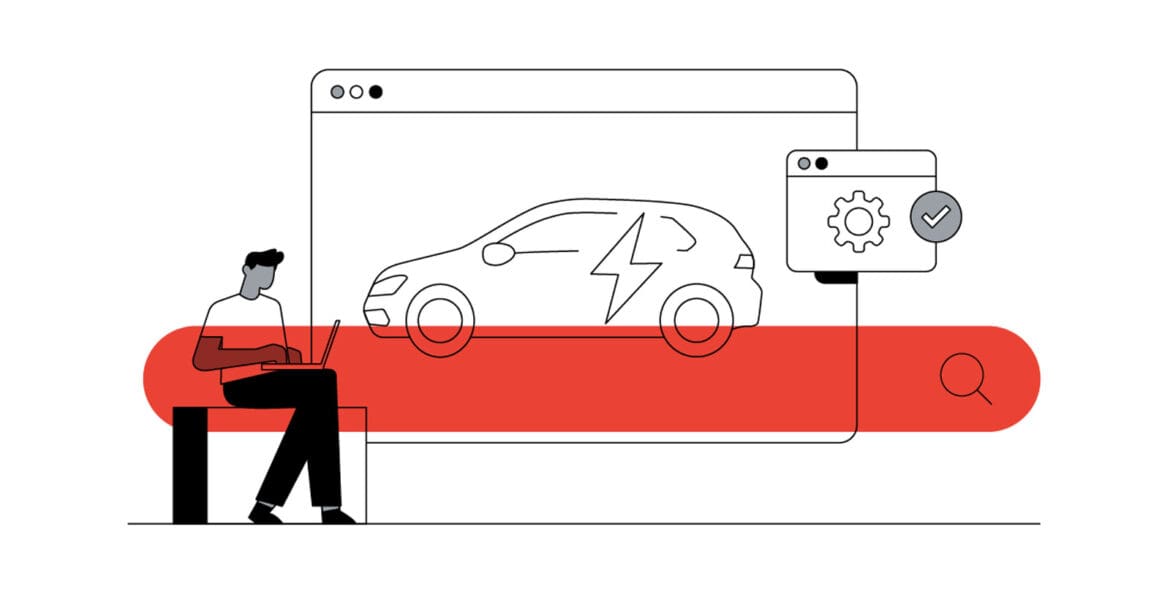By Thomais Zaremba
Flying cars may have been a sign of the times on “The Jetsons” but in real life, electric vehicles (EVs) are ushering us into the future. Just as gas-powered engines replaced horse-drawn carts a century ago, EVs are disrupting the industry and setting the standard for the next hundred years of auto innovation.
In short, EVs are taking over. EV sales in the U.S. rose 62% in the first half of this year and now make up 5% of new car sales. While this may sound small, it actually marks a tipping point for EV adoption. The shift to EVs could also accelerate rapidly, as drivers are still feeling squeezed by higher gas prices. In fact, searches for “best gas mileage” are growing globally by 90% year over year.1 And, according to industry analysts, about 45% of new car sales could be electric by 2035.
These numbers have helped automakers see the EV light. They’re investing over $526 billion in an all-electric future, which includes building new assembly lines and parts, learning to produce and store batteries and preparing for changing tax implications.
But is their marketing keeping pace too? As brands work to get EVs in the hands of consumers, many auto marketers are still relying on an outdated playbook. Here are three ways they can rethink stale strategies and make their EV marketing as electric as their vehicles.
3 ways auto marketers can repurpose stale strategies for electric vehicles. Video player: Build brand recognition with video. Search bar & people: Meet curious customers in search results. Rotating gear: Accelerate the path to purchase with automation.

Build brand recognition with video
An avalanche of EVs is coming, leading to a crowded marketplace. The 2022 Bank of America Merrill Lynch Car Wars report projects that by 2026, 60% of the new models launched will be electric or hybrid.2 And more models mean more choices for auto shoppers.
In addition to a crowded market, automakers will also have to contend with the fact that EV models do not have the same level of brand recognition that gas-powered vehicles do. Indeed, 1 in 4 consumer searches for EVs are unbranded.3
We found that 80% of new auto purchasers took an action after watching a video.
This means automakers need to build brand recognition for new vehicles now to be well positioned and top of mind when EV options increase for shoppers. One way to achieve this is through video ads that can differentiate a brand’s EV from the competition by touting its unique selling points. In our studies, we found that 80% of new auto purchasers took an action after watching a video,4 such as searching online for more information, visiting a dealer website, scheduling a test drive or creating custom specifications for a new vehicle online.
Meet curious customers in search results
To see how high consumer interest in EVs is, you only need to look online, where searches for EVs are accelerating. People are also looking for more detailed information about EVs, which suggests they might be heading further into the consideration phase. For example, while searches for “electric vehicle” have grown 87% year over year globally,5 more detailed searches like “electric vehicle charging station” have also grown by 80%.6 And searches for “best electric cars 2022” have grown in the U.S. by over 5,000% year over year.7
This gives brands the opportunity to meet people in search results and answer their most common questions and concerns. This in turn will help brands become a major part of customers’ path to purchase, guiding them every step of the way. But which search subjects should brands focus on?
The most researched EV topics are general explorations, charging information, maintenance and environmental benefits.
According to Gearshift, the most researched topics by people interested in EVs are general explorations of EV or hybrid vehicles, vehicle charging information, maintenance and environmental benefits.8 And notably, the top two concerns that prevent people from considering EVs are anxieties over vehicle charging or range and other technological issues.9
Accelerate the path to purchase with automation
Potential EV customers may be at an all-time high for consideration but they’re very unsure about making the final purchase. Most potential buyers are undecided on whether or not to buy an electric car and most of them won’t end up converting.10 In the end, just 33% of new U.S. car buyers who considered a plug-in hybrid or battery electric vehicle bought one.11
Real-time data from automated campaigns can help brands learn more about potential customers and tweak their messaging.
Approaching hesitant buyers with outdated marketing tactics and a one-size-fits-all message probably won’t make much of a dent, especially since the EV market is evolving so rapidly. Brands must be able to zig as customers zag and deliver tailored messaging to varying customer segments with different needs and concerns.
To do this at scale, brands should use automation and machine learning to deliver the right message to the right people at the right time. The real-time data from automated campaigns can also help brands learn more about potential customers and easily tweak their messaging to increase its effectiveness. By using these modern marketing tools, brands can convince hesitant buyers to choose a vehicle of the future.
As consideration and sales of EVs rapidly increase, automakers can set themselves up for success by using video to differentiate their brand and EV models from the competition, appearing in EV search results to answer customer questions and leveraging automation to deliver the right message to a wide range of consumers. To learn more about the electrification of auto marketing, listen to our latest episode of Auto On Air.
This article first appeared on Think with Google






